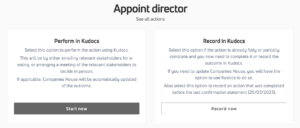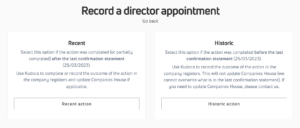Perform vs Record Recent vs Record Historic in Kudocs
What is the difference between Perform and Record in Kudocs?

In order to make most substantive changes to a company there are 3 elements that need to be completed:
- A legal step (e.g board or shareholder approval)
- An internal company records step (e.g. add details of a share issue to the share registers)
- Any other administrative steps (e.g. generate share certificates, file at Companies House, etc).
- The Perform route takes you through all 3 steps to make a specific change – covering all the legal and administrative steps (e.g. use Kudocs to handle authority to allot, pre-emption, subscription, deeds of adherence, board resolution to approve a share issue. Once all necessary legal steps are completed in Kudocs, the shares are issued and registers updated; share certificates generated, SH01 filed at Companies House, etc).
- This is a real-time process. So a particular step is completed when the relevant part of the process is completed – you cannot pre or post date any of this.
- The Record route is for when the legal steps have already been completed off system (e.g. approval has already given at an offline board meeting), but the administrative steps still need to be done using Kudocs. (e.g. update company records, notify Companies House, generate documents, etc).
- This is not a real-time process. So you can use this to record an event that has legally happened already (eg. shares were issued last week).
You can select whether to us Kudocs to Perform the entire action, or just Record the outcome of something that has already happened off line.
What does it mean to “Perform” an action in Kudocs? Using this route, Kudocs will help you complete all the necessary steps for a particular action in real time.
Kudocs has been designed by lawyers, so we know all the steps that need to be taken for this process to be complete. This usually consists of 3 parts:
(i) consents and legal approval (e.g. when appointing a new director, getting the new director to consent and then the company to approve the appointment)
(ii) update company records and Kudocs account (e.g. when appointing a director, adding the director to the register of officers and adding information to that stakeholder’s profile in Kudocs)
(iii) other administrative outputs, including filing documents at Companies House, generating share certificates, etc. (e.g. When appointing a director, filling the appointment at Companies House).
Using the Perform route saves you having to understand and make sure you follow all the correct rules and processes (or getting a professional advisor to do it for you). Kudocs does that all for you!
What is the difference between “Record Recent” and “Record Historic” in Kudocs?

The Record Recent route allows a company to complete consents/ approvals away from Kudocs, but then use Kudocs to do all the administrative leg work to update the current company information. The action is defined as “Recent” because it has happened since the last confirmation statement. Adding a recent transaction takes the current information and updates it based on the transaction you complete. E.g.
- a shareholder has 1000 shares currently in Kudocs; you record a recent share issue to that shareholder of 500 shares, their shareholding total will update to 1,500.
The Record Historic route is for a company to add past information to the company’s Kudocs account. The action is defined as “Historic” because it has happened before the last confirmation statement (or incorporation date or Full Onboarding date). Adding a historic transaction information will not change current information. E.g:
- add details of a director who was appointed and resigned in the past – the director is not added to the current board, their time of service is simply added as a historic fact.
- add details of a share issue that happened in the past (i.e. before the last confirmation statement). This does not update the current shareholding balance for that shareholder, it is just added as a historic fact (e.g. a shareholder has 1000 shares currently in Kudocs; you record a historic share issue to that shareholder of 500 shares, their shareholding total will remain 1,000).
- you complete full onboarding of a company and amend the shareholdings of “A” so that A has 100,000 shares. You want to add details of the transactions that explain how A acquired 100,000 shares. You record the incorporation share issue of 1 share as historic, then another historic issue of 999 shares – so the historic total is 1,000 shares. Kudocs does not mind that 1,000 does not equal 100,000 and it does not change the 100,000 to 1,000! You can leave it there, or you add other historic transaction – at your leisure – so that the historic total matches the current total.
If you would like more information about this, see here and/or please contact Kudocs.
What does it mean to “Record a Recent” action in Kudocs? Use this route to make recent changes to company information. “Recent” means since the last confirmation statement. This route is for when the legal/ consent steps of the action have already been completed (e.g. the directors have passed a resolution authorising the change), and you just need to complete the administrative outputs.
Kudocs has been designed by lawyers, so we know all the steps that need to be taken for this process to be complete. This usually consists of 2 parts:
(i) update company records and Kudocs account (e.g. when issuing new shares, adding the shares/ shareholder to the register of members and adding shareholder information to the stakeholder profiles in Kudocs)
(ii) other administrative outputs, including filing documents at Companies House, generating share certificates, etc. (e.g. when issuing shares, filling the new share capital at Companies House & generating new share certificates (including signatures and distribution to shareholders)).
What does it mean to “Record a Historic” action in Kudocs? Use this route to add past information to the company’s Kudocs account. The action is defined as “Historic” because it has happened before the last confirmation statement. Adding a historic transaction information will not change current information. E.g:
- add details of a share issue that happened in the past (i.e. before the last confirmation statement). This does not update the current shareholding balance for that shareholder, it is just added as a historic fact (e.g. a shareholder has 1000 shares currently in Kudocs; you record a historic share issue to that shareholder of 500 shares, their shareholding total will remain 1,000).
The only output of a historic action is to add the action/ transaction to the relevant company registers. There are no Companies House filings, share certificates, etc generated – as the transaction is historic so it is assumed that all these steps were done at the time. All you need to do is add a record of the event to Kudocs
If you would like more information about this, see here and/or please contact Kudocs.
Do I need to add full details of all historic transactions to Kudocs? No. Historic transactions are ‘dumb’ inasmuch as they do not change the current information – they are just entries about things that have happened in the past – before joining Kudocs.
This is particularly useful for historic share transactions – where you might want to add only some historic transactions, or at least not be forced to add the full history from day 1. Kudocs allows you to add what you want, when you want to. Each transaction you add is ‘dumb’ and standalone (ie it does not affect anything else.
Why does Kudocs shows “N/A” for the “balance of shares after transaction” in the register of members exports for historic transactions? Kudocs does not require the user to enter all the historic transactions or to add them in chronological order. So, e.g., you have a shareholder who now owns 100 shares, but has been involved in a number of share transactions over the years. You want to add details of those transactions. You start by recording an historic share issue of 1,000 shares (that does not alter the fact that the shareholder currently only has 100 shares). Kudocs will show the balance after that transaction as “N/A” as you may have other share transactions to add: Kudocs doesn’t know and does not force you to add them. This is simply a transaction that happened in the past and is treated as a standalone. The true balance after the transaction in question may or may not be 1,000. You could stop there or you could then add more transactions – it is completely up to you, but Kudocs does not validate for you. Kudocs does not, intentionally, force users to add all historic transactions or to confirm that they have done so to run the calculations.